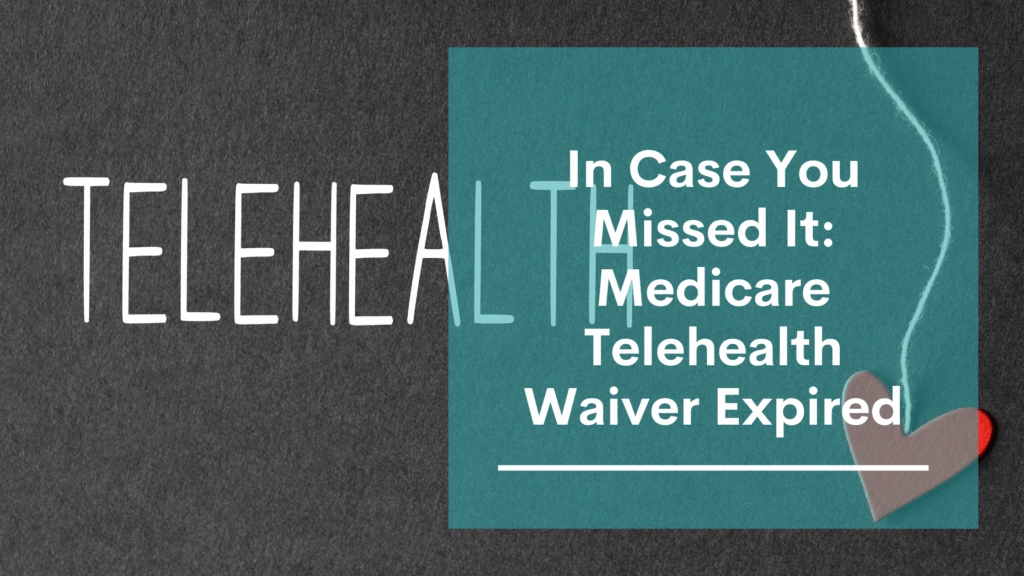Effective October 1, 2025, the Medicare in-person telehealth waiver has officially expired. After years of expanded telehealth access, Congress did not pass last-minute legislation to extend or make the waiver permanent. For behavioral health providers, this marks a major shift in how Medicare patients can receive care, and it’s critical to understand the new requirements immediately.
Here’s what you need to know.
Why This Matters
Telehealth has been a lifeline for both patients and providers since the COVID-19 pandemic. It expanded access to care for patients who face barriers such as transportation, health risks, or lack of nearby providers. Behavioral health, in particular, saw a tremendous increase in telehealth utilization, allowing patients to maintain continuity of care and providers to serve a broader range of individuals.
The expiration of the waiver means that Medicare is rolling back to its pre-pandemic rules, though some provisions remain in flux as the Centers for Medicare & Medicaid Services continues to issue clarifications.
What’s Changed Under Medicare
According to recent guidance and updates from the National Association for Behavioral Healthcare (NABH):
In-person requirement resumes, but with uncertainty:
As of October 1, 2025, CMS requires that if patients receive a mental health telehealth visit, they must have had an in-person visit within the past 6 months (and every 12 months after the initial telehealth visit). However, due to ongoing uncertainty, CMS has not yet clarified whether established patients will be grandfathered in under the old waiver rules or whether the 6-month in-person requirement will apply to all patients.
Temporary flexibility for waiving in-person visits:
CMS has indicated that patients and providers may agree to waive the in-person visit if the “risks and burdens of travel outweigh the benefits of an in-person encounter.” In these cases, the practitioner must document the reason for the waiver in the patient’s medical record. CMS also allows the required in-person service to be completed by a colleague in the same subspecialty within the same group practice if the original clinician is unavailable.
Scope of impact:
This policy change only affects Medicare mental health telehealth visits billed under the Physician Fee Schedule. It does not impact Medicaid, commercial insurance, PHP/IOP, IPF, or substance-use-only services.
Ongoing confusion:
Because Congress failed to extend the flexibilities and the federal government shutdown delayed further CMS guidance, many providers remain unsure how to bill Medicare telehealth services correctly. NABH and other national organizations are urging CMS to provide additional clarification soon.
Commercial insurance unaffected (for now):
Unless otherwise notified, this change applies only to Medicare beneficiaries. Commercial insurance companies have not reinstated in-person requirements, but they often follow Medicare’s lead, so it’s something you should keep an eye out for.
What This Means for Your Practice
What This Means for Your Practice
- Scheduling complexity increases. You’ll need to build in more in-person appointments for Medicare patients to remain compliant or to document when an in-person visit was waived.
- Patient communication is critical. Patients accustomed to full telehealth access may be surprised or frustrated by the new requirements. Transparent communication about what Medicare requires, and why, will help maintain trust.
- Documentation requirements return. Carefully record all in-person visits and any waivers to ensure compliance during audits or claims reviews.
- Revenue cycle implications. Non-compliance could result in claim denials or reimbursement delays. Practices that don’t adapt quickly may experience financial disruption.
Steps to Take Now
Here are some proactive measures providers can take to prepare for and manage the new rules:
- Audit your current Medicare telehealth caseload. Identify which patients may be impacted by the new requirements and when their next in-person appointment should be scheduled.
- Educate your front office and scheduling staff. Make sure your team knows which patients need in-person visits so they can guide scheduling appropriately.
- Develop patient-friendly messaging. Whether it’s via phone calls, emails, or patient portals, prepare clear language to explain why in-person visits are now required.
- Track updates from policymakers. The telehealth landscape continues to evolve, and further changes could come later this year depending on legislative action.
Resources for Mental Health Providers Providers
The American Psychological Association (APA) has created detailed guidance on how to prepare for the return of in-person requirements. You can access it here: APA Guidance on Medicare In-Person Telehealth Requirement.
The expiration of the telehealth waiver is a reminder that policy shifts can happen suddenly and dramatically impact behavioral health providers. By staying informed and proactive, your practice can remain compliant while continuing to provide high-quality care.
If you need help navigating your mental health billing, Anchor Point Billing Solutions is here to support you every step of the way.

